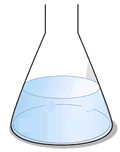|
The term yield means "that which is produced" in a chemical reaction. There are many reasons why the expected yield is lower than the amount calculated using the stoichiometry of the equation. There may be other reactions involving the same reactants that compete with the expected reaction and make different products - this is often the case in organic chemistry. There may be product lost during the purification procedure. Some of the product may get decomposed in the course of extraction. The actual reaction may not go to completion, instead an equilibrium is established. |
|
Theoretical yield
The theoretical yield means the amount of a product that would be made, calculated from the stiochiometry of the equation, using the moles of the limiting reagent (see previous page)
|
Example Calculate the theoretical yield of iron(II) hydroxide formed when 50cm3 of 1M FeSO4 is added to 100cm3 of 2M NaOH [Fe=56, O=16, H=1] Equation for the reaction: 2NaOH + FeSO4 2 moles of sodium hydroxide react with 1 mole of iron(II) sulfate From the data given,, moles of iron(II) sulfate = 0.05 x 1 = 0.05 moles This would require 0.05 x 2 = 0.1 moles of sodium hydroxide Moles of sodium hydroxide = 0.1 x 2 = 0.2 moles - the sodium hydroxide is in EXCESS and the iron(II) sulfate is the limiting reagent. From the equation, 1 mole of iron(II) sulfate makes 1 mole iron(II) hydroxide Therefore 0.05 moles iron(II) sulfate theoretically makes 0.05 moles of iron(II) hydroxide Mr iron(II) hydroxide = 56 + 2(16 +1) = 90 Therefore theoretical yield of iron(II) hydroxide = 90 x 0.05 = 4.5 g * * a big thank you to Hubert Kitlinski, for spotting the mistake. |
Percentage yield
The fraction of the theoretical yield is calculated by using the actual experimentally obtained amount of product and dividing it by the amount expected in theory. The percentage is obtained by multiplying this fraction by 100.
For example, if the theoretical yield is 8 g, but after collection we find that there is only 6 g, then the percentage yield is 6/8 x 100% = 75% yield.
It does not matter whether moles or mass is used for the calculation as long as the two units are not used at the same time.
|
Example: In an experiment to prepare a sample of aspirin (C9H8O4), 13.8 g of salicylic acid (C7H6O3) was reacted with 15g of ethanoic anhydride (C4H6O3) according to the equation: C7H6O3
+ C4H6O3 Find the limiting reagent and theoretical yield. Calculate the percentage yield if 2.5g of aspirin was obtained. [C=12, O=16, H=1] From the equation we see that moles of salicylic acid = moles of ethanoic anhydride Mr salicylic acid = (7 x 12) + (6 x 1) + (3 x 16) = 138 From experimental data, moles of salicylic acid = 13.8/138 = 0.1 moles Mr ethanoic anhydride = (4 x 12) + (6 x 1) + (3 x 16) = 102 From experimental data, moles of ethanoic anhydride = 15/102 = 0.147 moles The ethanoic anhydride is in excess and the salicylic acid is the limiting reagent. From the equation, moles of salicylic acid = moles of aspirin. Theoretical yield of aspirin therefore = 0.1 moles Mr aspirin = (9 x 12) + (8 x 1) + (4 x 16) = 180 Theoretical yield of aspirin = 180 x 0.1 = 18g Actual experimental yield of aspirin = 2.5g Percentage yield = 2.5/18 x 100 = 13.9% (3 sig figs) |


